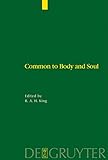Common to Body and Soul : Philosophical Approaches to Explaining Living Behaviour in Greco-Roman Antiquity / ed. by Richard A.H. King.
Material type: TextPublisher: Berlin ; Boston : De Gruyter, [2008]Copyright date: ©2006Description: 1 online resource (279 p.)Content type:
TextPublisher: Berlin ; Boston : De Gruyter, [2008]Copyright date: ©2006Description: 1 online resource (279 p.)Content type: - 9783110183337
- 9783110196511
- online - DeGruyter
- Issued also in print.
| Item type | Current library | Call number | URL | Status | Notes | Barcode | |
|---|---|---|---|---|---|---|---|
 eBook
eBook
|
Biblioteca "Angelicum" Pont. Univ. S.Tommaso d'Aquino Nuvola online | online - DeGruyter (Browse shelf(Opens below)) | Online access | Not for loan (Accesso limitato) | Accesso per gli utenti autorizzati / Access for authorized users | (dgr)9783110196511 |
Frontmatter -- Contents -- Introduction -- Parmenides on Thinking -- Parmenides on the Place of Mind -- Life Beyond the Stars:Aristotle, Plato and -- Empedocles -- Plato's phaulon skemma: On the Multifariousness of -- the Human Soul -- "Common to Soul and Body" in the Parva -- Naturalia -- What's New in the De Sensu? The Place of the De -- Sensu In Aristotle's Psychology -- Common to Body and Soul: Peripatetic Approaches -- After Aristotle -- Interaction of Body and Soul: What the Hellenistic -- Philosophers Saw and Aristotle Avoided -- Psychophysical Holism in Stoicism and -- Epicureanism -- Body and Soul in Galen -- Backmatter
restricted access online access with authorization star
http://purl.org/coar/access_right/c_16ec
Der Band versammelt Beiträge zur philosophischen Erklärung der Beziehung zwischen Körper und Seele in der Antike von den Vorsokratikern bis Galen. Er enthält Beiträge über das Denken bei Parmenides (E. Hussey, R. Dilcher), die Liebe bei Empedokles (D. O’Brien), die Dreiteilung der Seele bei Platon (T. Buchheim), Aristoteles – vor allem die Parva Naturalia – (C. Rapp, T. Johansen, P.-M. Morel), nacharistotelische Peripatetiker (R. Sharples), hellenistische Philosophie (C. Rapp, C. Gill) und Galen (R. J. Hankinson). Der Titel spielt auf einen Ausdruck bei Platon, Aristoteles und Plotin an, der sich auf Aspekte des Lebendigseins an Körper und Seele bezieht und ein Topos in der antiken Philosophie wurde, der bei den verschiedenen Autoren unterschiedlich behandelt wurde.
The volume presents essays on the philosophical explanation of the relationship between body and soul in antiquity from the Presocratics to Galen, including papers on Parmenides on thinking (E. Hussey, R. Dilcher), Empedocles’ Love (D. O’Brien), tripartition of the soul in Plato (T. Buchheim), Aristotle – especially the Parva Naturalia – (C. Rapp, T. Johansen, P.-M. Morel), Peripatetics after Aristotle (R. Sharples), Hellenistic Philosophy (C. Rapp, C. Gill), and Galen (R. J. Hankinson). The title of the volume alludes to a phrase found in Plato, Aristotle and Plotinus, referring to aspects of living behaviour involving both body and soul, and is a commonplace in ancient philosophy, dealt with in very different ways by different authors.
Issued also in print.
Mode of access: Internet via World Wide Web.
In English.
Description based on online resource; title from PDF title page (publisher's Web site, viewed 01. Dez 2022)


